I’m not a baker, so no banana bread or sourdough challenges for me this lockdown. And I live in a tiny studio apartment so I have no stairs to ascend to match the distance of Ben Nevis. But what I do like is an invitation to join a creative jewellery challenge, one that takes as its starting point a object held within our Museums collection, that will inspire those students unable to get to the their schools’ studios, foster material experimentation and creative thinking for us all whilst we were in lockdown, and importantly to have a bit of fun in how to present the pieces in a styled look. And when it is initiated by the award-winning jeweller and digital craft artist Silvia Weidenbach, how could I say no?
Museums and their collections have been a continual source of inspiration for artists and makers over the years. Silvia’s own practice is inspired by her ongoing fascination and research into ornamentation. She often works with Museum’s collections to re-contextualise them and their significance, drawing out new insights and dialogues around ornamentation to produce striking, unique jewels that explore subjects of beauty, symmetry, the precious and the grotesque.
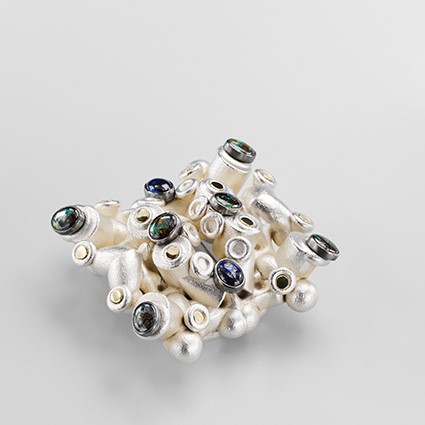
“I have always been inspired by our heritage and the extravagance, ornamentation and exquisite craftsmanship that it displays. Talking with experts about how and when these objects were produced, taking inspiration not only from the exquisite objects but also getting a wider understanding of the world they were produced for and the people who used them, allows me to create pieces that are more own hybridised understanding of history but are very much for the contemporary world.”
So it was natural for Silvia to extend this fascination to her students at Glasgow School of Art – within Silversmithing & Jewellery – where she is a tutor. And to teach them what a vast resource of inspiration museums are.
Since she was unable to bring them physically to the collections, she contacted her friends in the museum sector to ask them to help her create a series of challenges that had at the core an object from the Museum’s collection. And to give a wee virtual lecture to the students about the Museum and the resources we have online for them to be inspired by, the chosen artefact, and the challenge we would like them to undertake. Oh, and we would also be asked to make our own versions ourselves.
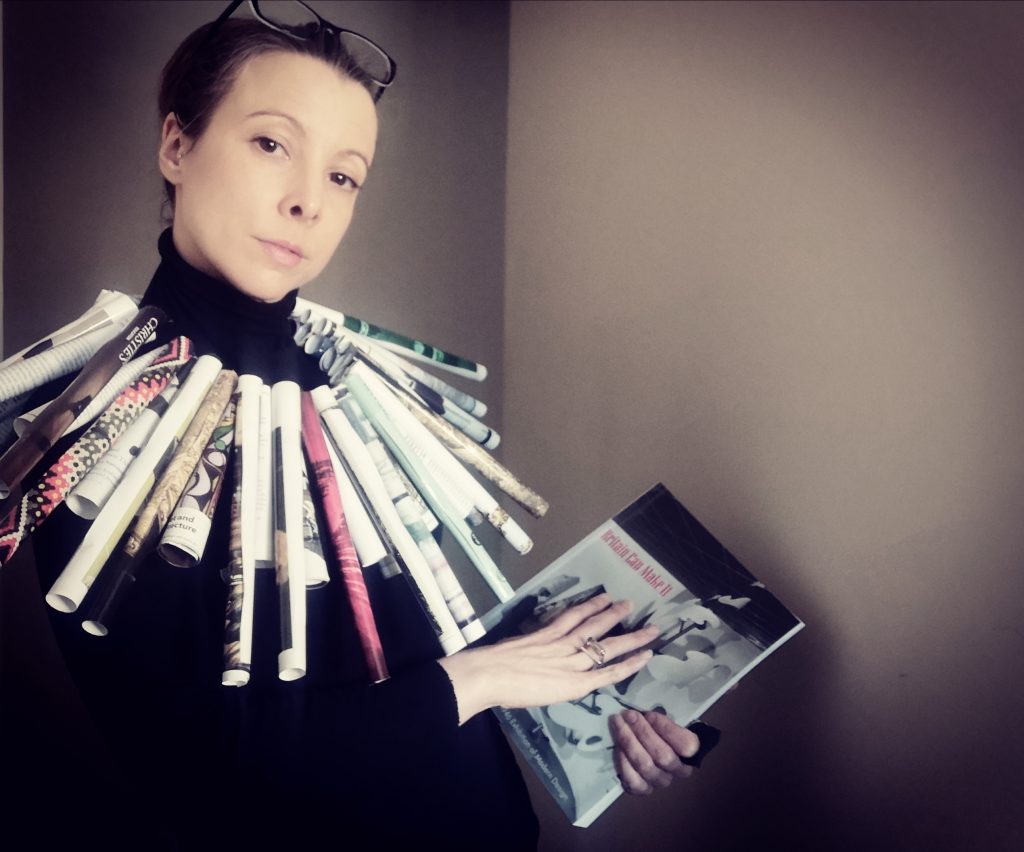
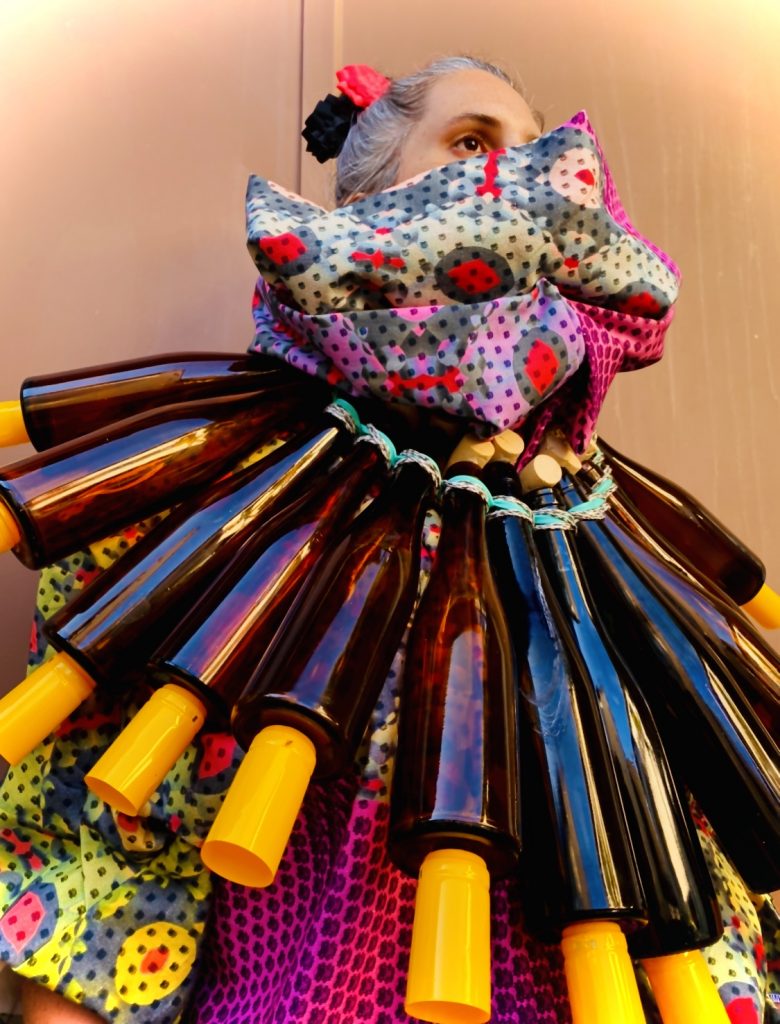
Me and my ruff and Silvia rocking out in hers on the Royal Museums Greenwich Instagram account, it helps that she’s back in Germany and has access to the family’s vineyard bottles. Images © Sarah Rothwell and Silvia Weidenbach
The first museum collaboration was with Matilda Pye at The Queen’s House, part of Royal Museums Greenwich, #ruffchallenge saw the students creating their own version of a ruff inspired by the Armada Portrait of Queen Elizabeth I. My own version was created using a stash of back-dated issues of Art Quarterly‘s the publication for Art Fund members. I thought this would be quite fitting as the imagery it contains relates to my occupation as a Museum Curator, so there would be subtle hints and glimpses within the ruff. In addition the Art Fund was also instrumental in the campaign to save the Armada Portrait for the nation. The publication I hold is entitled Britain Can Make It, this was a seminal fair that was held in the late 1940s to rejuvenate British industry after the Second World War. But I feel more that the title is poignant for this period of uncertainty in relation to the Lockdown, as a message of hope.
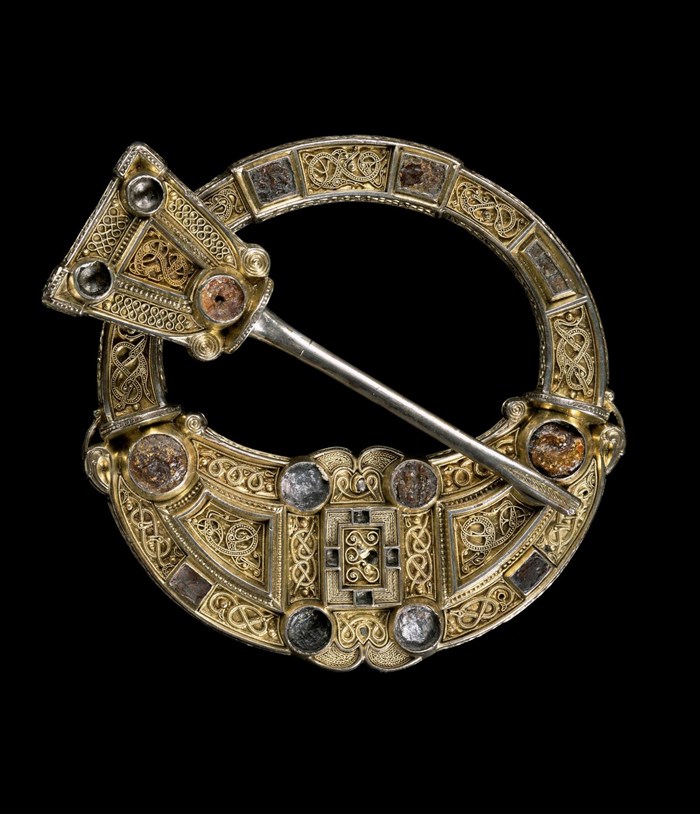
Then it was our turn to set the challenge. Scotland as well as many other of the Celtic nations, has a long history of penannular brooches. Initially these were functional, used to hold the material of an individual’s clothing together. These circlets with intersecting pin, developed and became emblems of wealth and prestige, and were often embellished with symbols of Celtic culture. So an ideal piece of jewellery for the students to consider in regards to function, decoration and the potential to be adapted for contemporary styling. Again, as this would require using whatever materials were to hand in lockdown, I hit upon the idea of introducing the students to the Punk Jeweller Judy Blame, who used anything he found to create revolutionary pieces and looks. He who was also inspired by historical collections and artefacts. We asked them, like Blame, to think creatively with their material explorations and experiments. And to be brave with how they approached working with anything they found. To be rebellious, to be a #coronapunk!
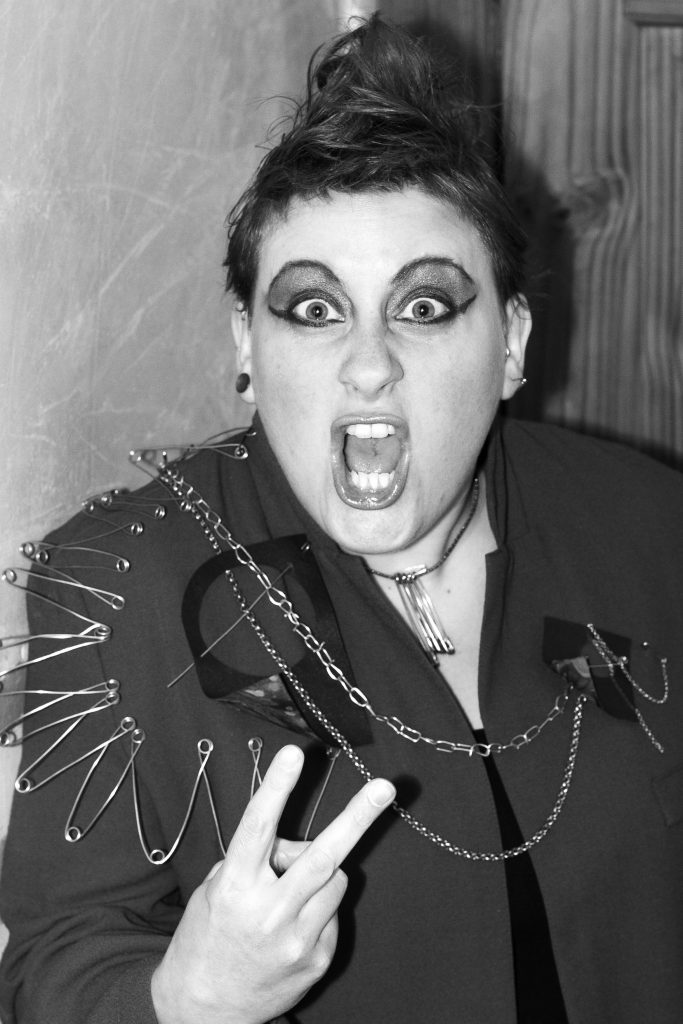
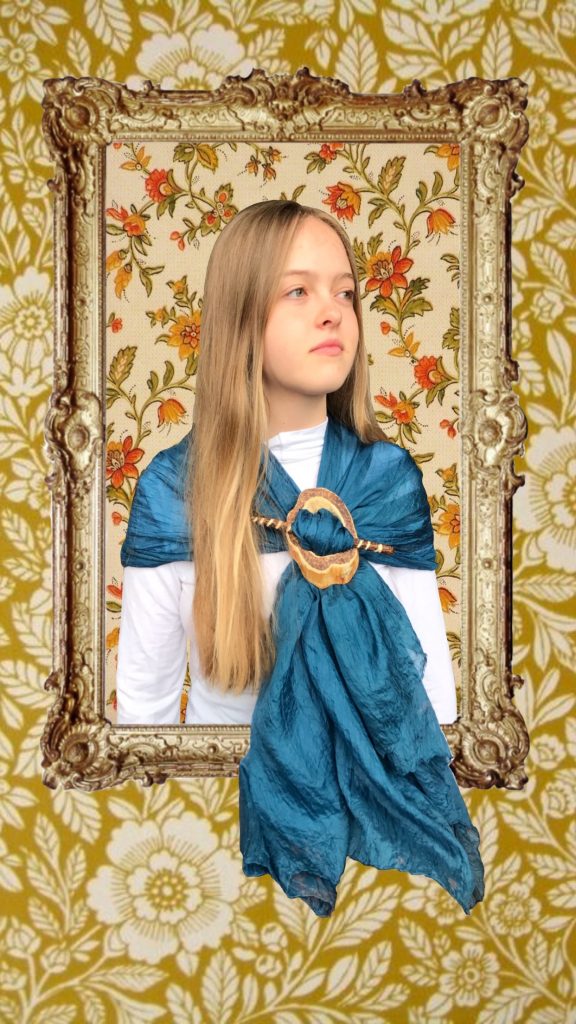
Sarah Wilmott playing at being a punk in her #coronapunk jewels created using book bindings, safety pins and chains she found and crafted herself. Image © Sarah Wilmott. Whereas Megan Vischer’s sister models her Arts & Crafts inspired brooch she created using a branch from her garden. Image © Megan Vischer.
The results were edgy and fun as you can see above from Sarah’s piece that continued on from her #ruffchallenge theme of utilising publications, and really challenged their creativity and material experimentation. From unused gig tickets for events cancelled due to the lockdown, raiding the cutlery draw, demonetarised bank notes, to even growing salt crystals, the students brought a unique twist to an iconic historical jewel. The images they shared and the inspiration behind their pieces were fantastic. Some were inspired by folklore, others by the times we live in, and all worked materials they found at home into wonderful contemporary jewels.
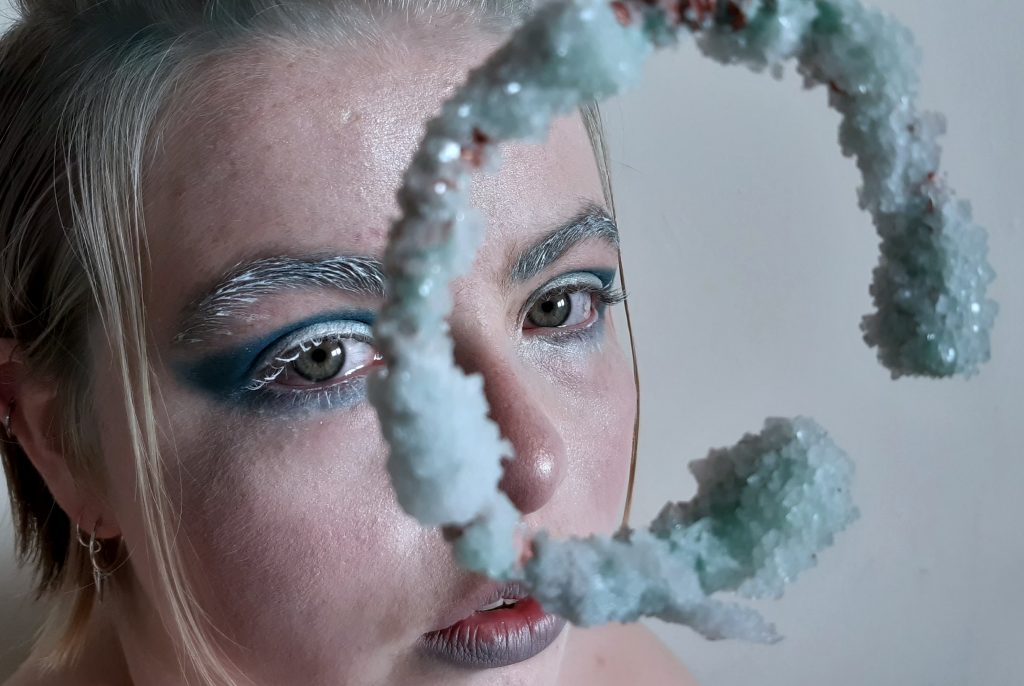
Jenny McElroy for instance was inspired by Scottish Folklore due to the fact one of the Museum’s collection of pennanular brooches was found on the Island of Rousay, close to her home in Orkney.
“I grew salt crystals onto a copper ring to form my piece, as a sort of tribute to the Fin folk and their mourning for the island. If the salt is submerged in water it will dissolve and disappear much like this fragile tether of the island to where it came from. The island was originally named Hyn-hallow (the hinmost holy – the last island to be made holy), therefore I created this brooch to serve as a reminder that the island did not always belong in this world, and still has magical properties causing strange things to happen after sunset.”
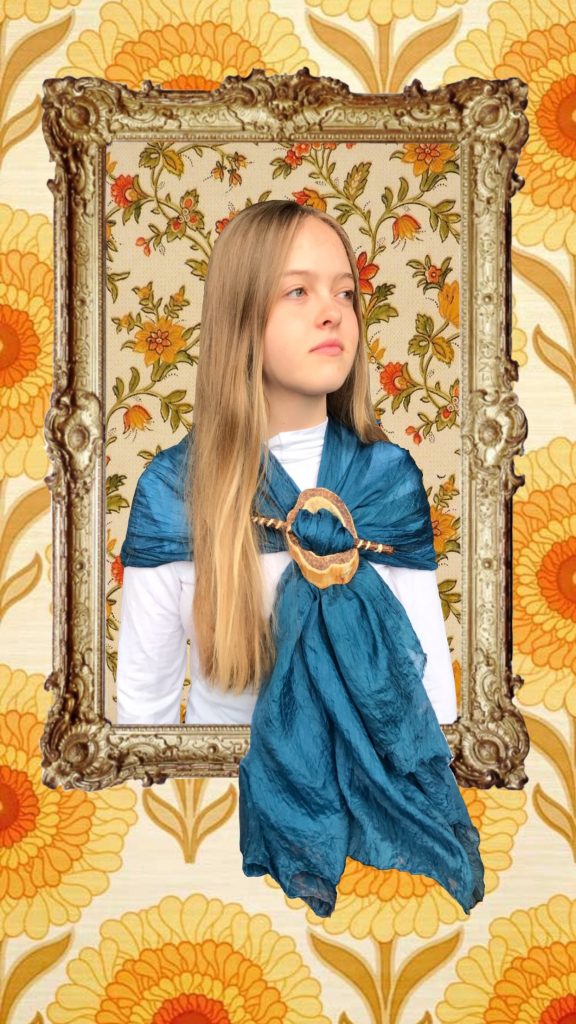
Megan was also inspired by her environment and responded to the brief to create a more historically-inspired portrait. “With this project’s brief in mind, I knew I wanted to make something a little out of the ordinary so I began by exploring various potential materials, but it was only when I was out in the garden that an old tree stump gave me an idea. My piece was entirely inspired by nature, but I wanted to show a stark comparison between that and a more vibrant/‘punk’ setting for my final images, which were inspired by Maisie Broadhead’s portraiture. My images show a harmony between my natural carved brooch and a bright background.”
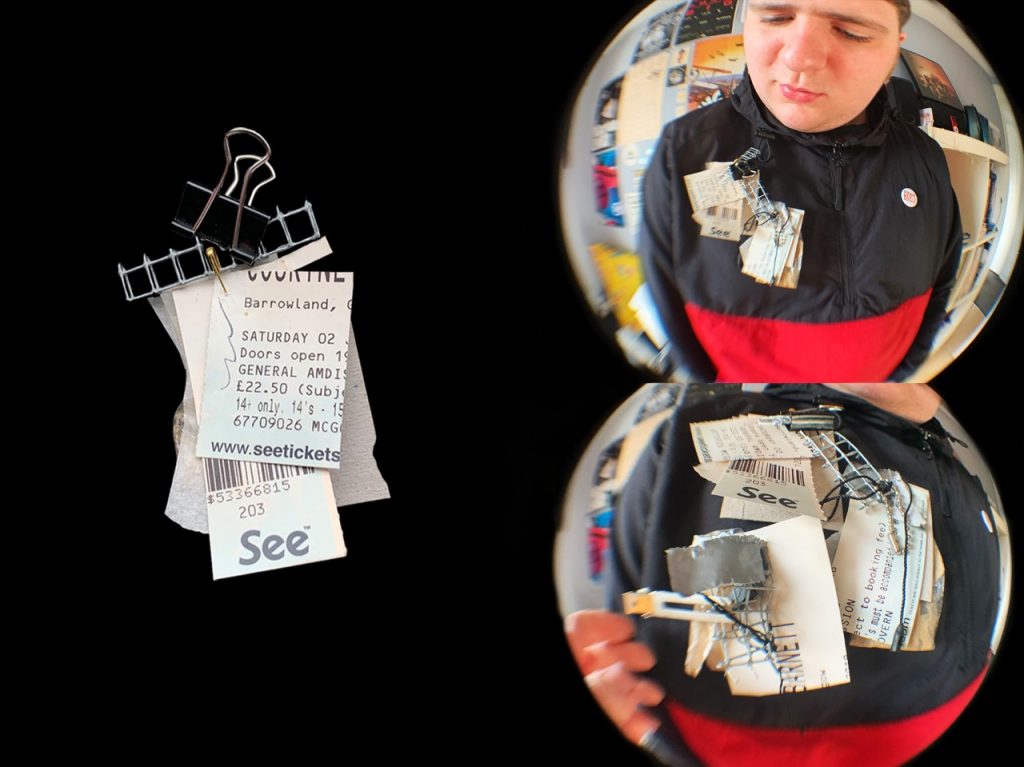
Whereas Vhari McGovern was “Inspired by Glasgow’s punk culture and music scene, my brooch is a collection of disregarded possessions taken from my brother who plays in a Glaswegian punk band. Made from duct tape, mesh wire, safety pins and dismantled gig tickets, I wanted to make a piece reminiscent of live gigs during a time when they are only a memory.”
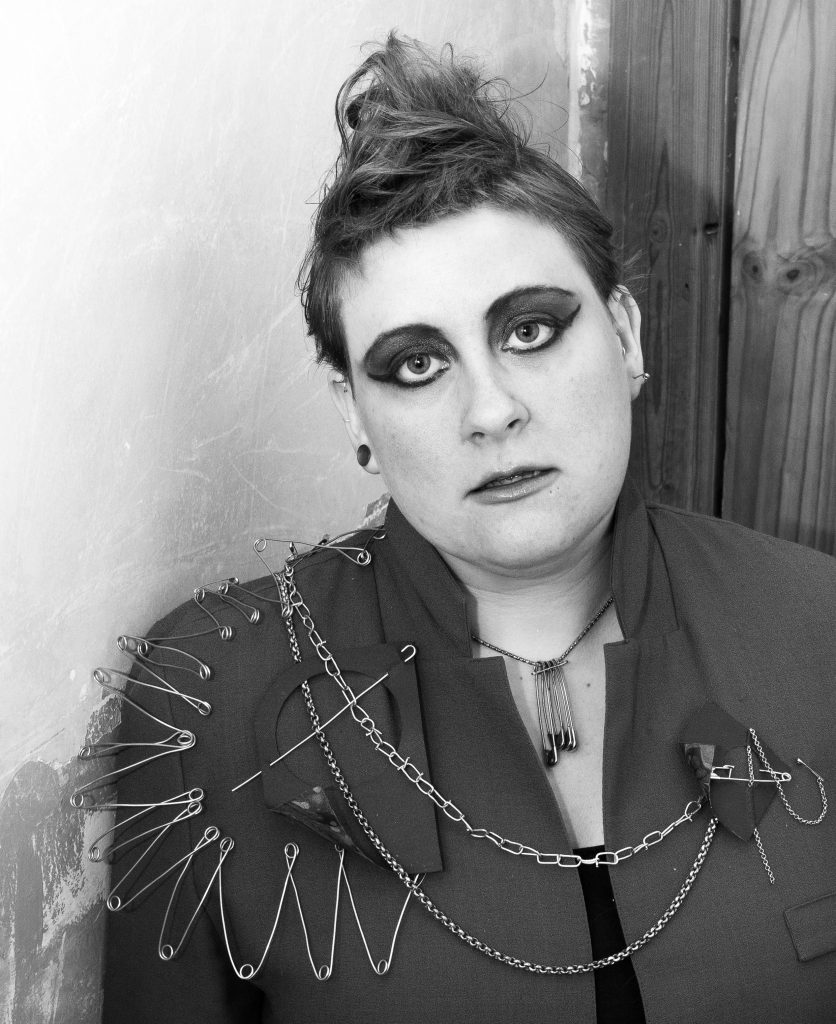
And as I mentioned Sarah Wilmott “created a piece drawing on my previous career working in a library. I used a combination of traditional bookbinding materials such as buckram and marbled paper, combined with chains to resemble the historical academic libraries in which knowledge equalled power and status. I was interested to draw a comparison between the juxtaposed worlds of medieval libraries and punk Britannia… Fashion, music and literature were all important mechanisms for disseminating the cultural identity of this group.”
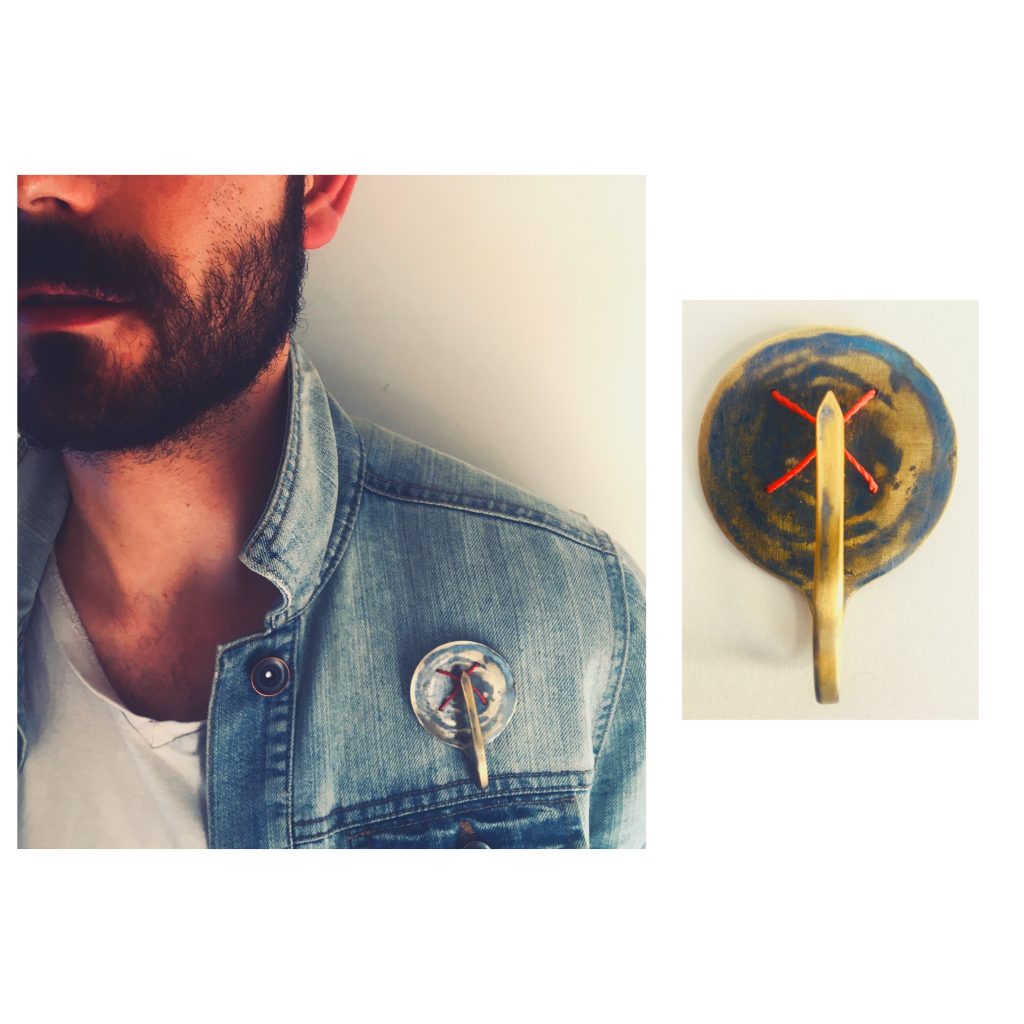
Ava’s partner looking rather cool in her cleverly manipulated spoon piece. Image © Vica Gabor.
Using what was to hand in new ways was also taken onboard by fellow student Vica Gabor, who “wanted to use an everyday object and change it into a wearable piece. I had this tiny spoon, that I simply flattened straight and for the circle I pierced a slice of a brass pipe tube I had on hand. With the second stage I wanted to create a piece that looks rebellious and spontaneous to reflect the topic and make a punk piece. Something that doesn’t follow the rules, my intention was to express this sort of playfulness and freedom.”
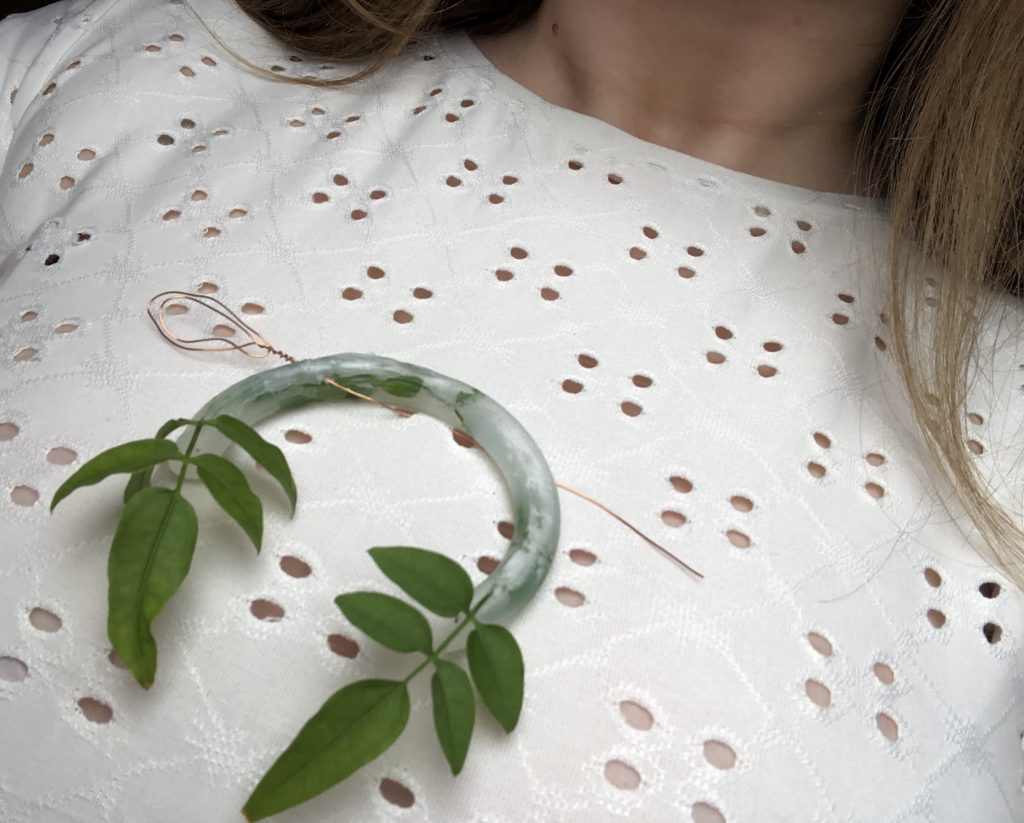
And for Lori Baird, she “wanted to use the Coronapunks challenge as a way of expressing my own feelings and many others’ feelings during the coronavirus outbreak. I created my penannular brooch by setting leaves and their stems in soap. I wanted this to convey the overwhelming feeling of being stuck or frozen in time right now with the current lockdown regulations. I was also influenced to use soap as the setting material as its significance and importance has increased over the past few months. This resulted in the ephemeral and very cathartic finished brooch”.
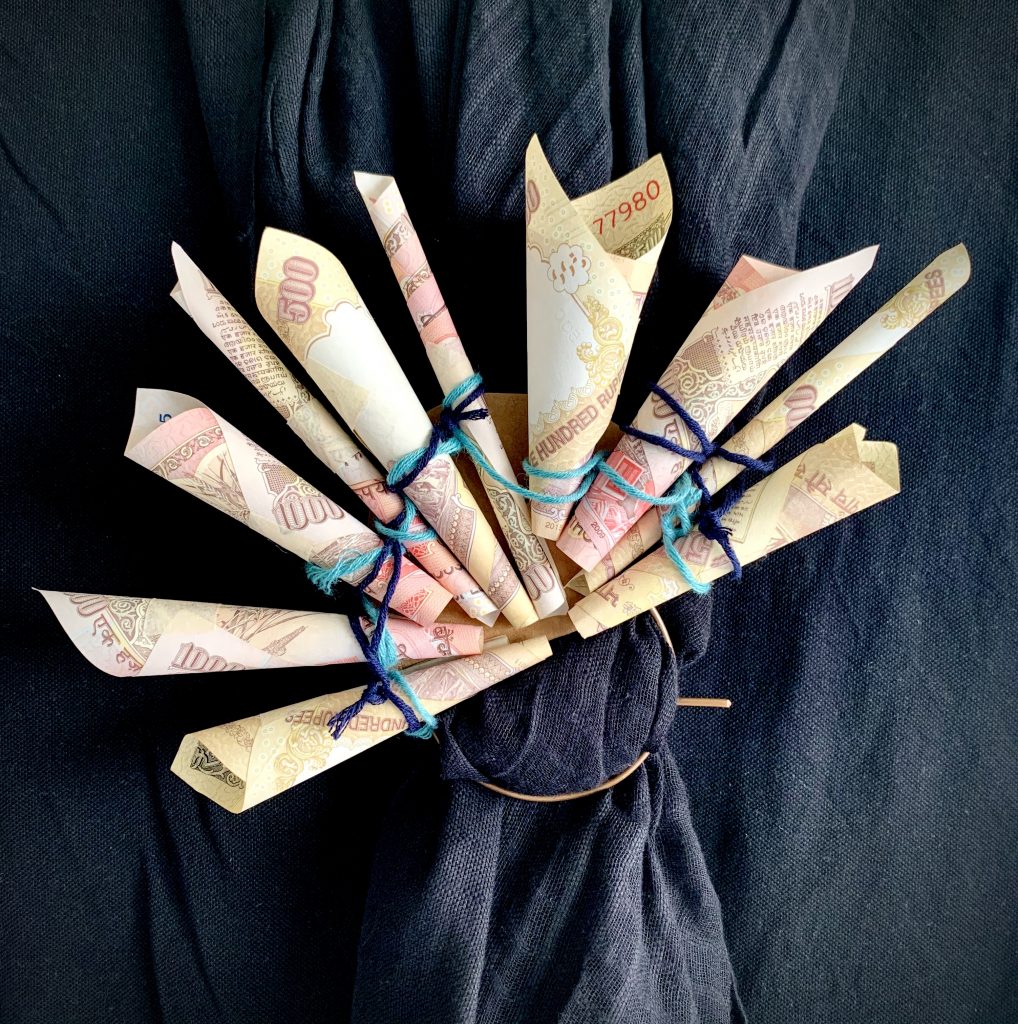
Many of the students who attend GSA are not UK residents and had returned home. Pranathi joined us from her family’s home in India, and was not as knowledgeable about the Punk movement. However following my lecture on Judy Blame she became “inspired to find something unorthodox and work with. In 2016, there was a demonetisation of the ₹500 and ₹1000 banknotes here in India, and there was a time limit for the exchange of these. Way past the deadline, quite a few of them were discovered at home in an old wallet, back then, it was a pity but now, are exceptional materials. I made a brooch with these bank notes and the same penannular mechanism I was fascinated with. Though these have no actual monetary value, I couldn’t get myself to destroy them, so my shapes and forms are predominantly based on conserving the notes!”.
Seeing all these pieces and hearing the students explain the reason behind how they created them and the look they chose to capture was lovely and rewarding to know that I had helped introduce the class to not only the Museum and its collection – as well as an influential designer and maker within the field of jewellery – but also a movement that came at a time of social and economic unrest, highlighting that creativity can and will flourish even at the worst of times. And how with little tools or resources, you can be inspired and make.
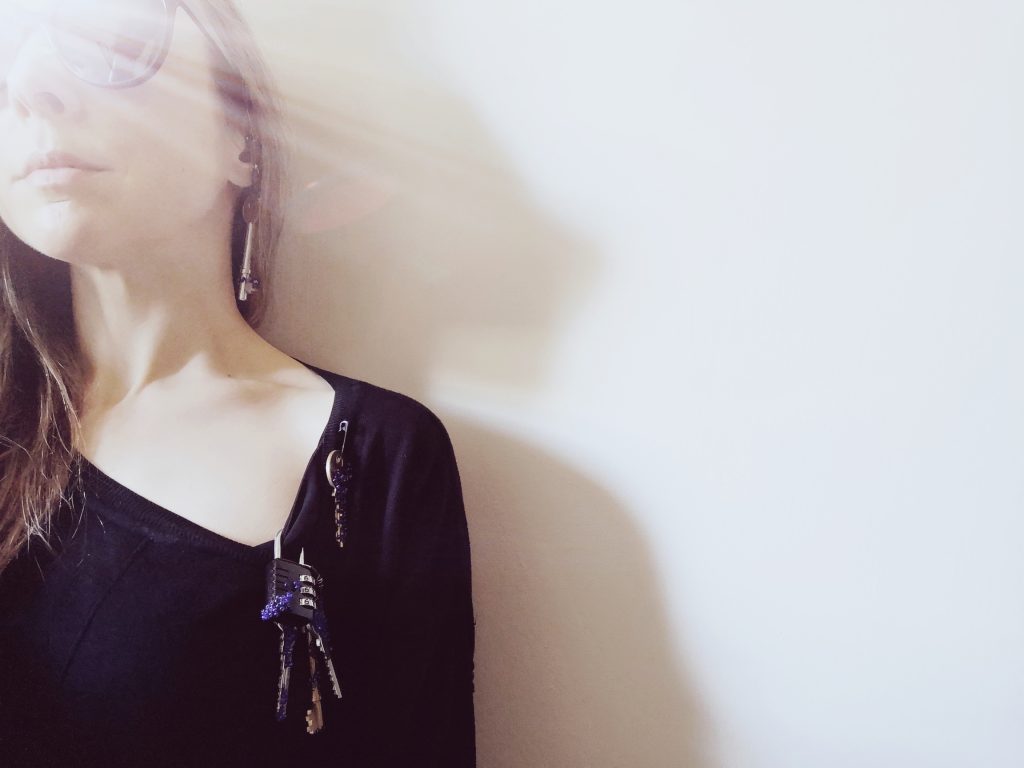
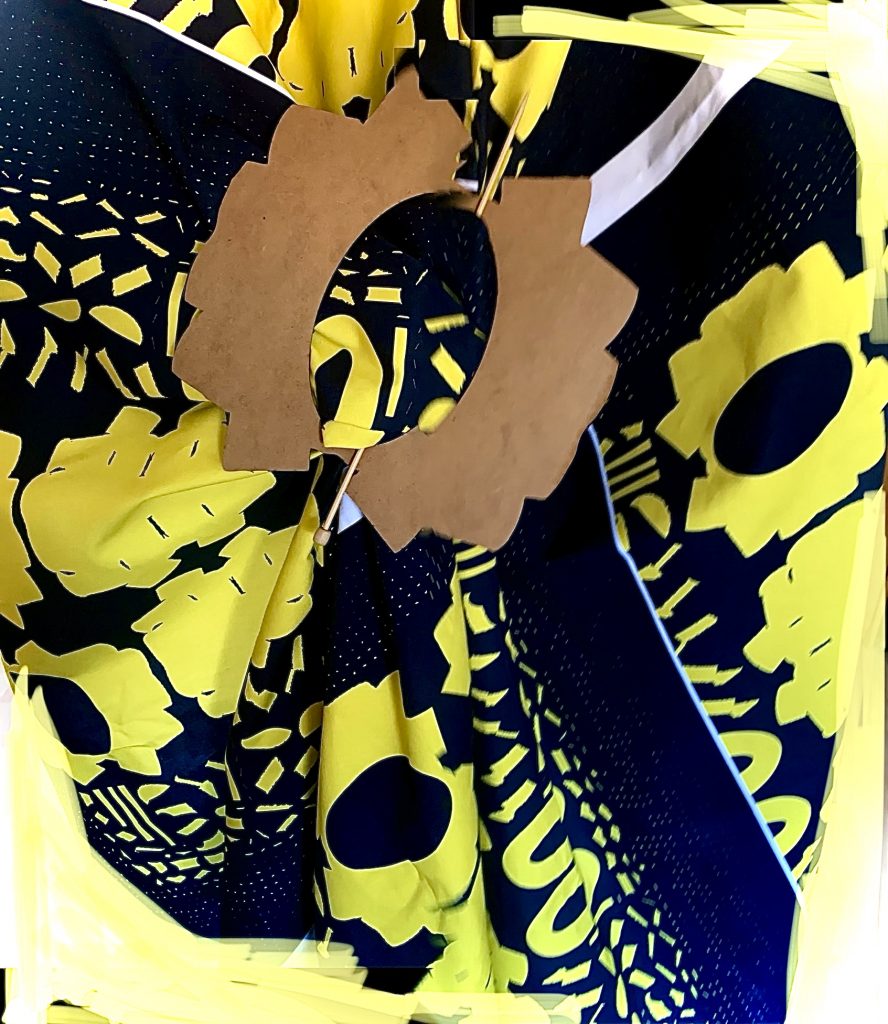
Me wearing my #coronapunks padlock and key brooch and earrings, covered in a visual bacteria, and Silvia with her geometric brooch inspired by her textile designs and using her mums knitting needle as a pin. Images © Sarah Rothwell and Silvia Weidenbach
Personally I found the challenge so much fun, even if I nearly super glued my fingers together. And it was lovely to be asked by Silvia to be involved in helping to create a challenge which continued to inspire the students to consider how anything you find can be turned into something beautiful. I also feel if I can do this from my wee studio, with minimal resources and limited technical skills anyone can. So go on give it a go, just remember to tag the Museum into any of your creations, as we would love to see them.
#coronapunks is the second collaboration between the team at The Glasgow School of Art and a series of significant Museum collections that will see further collaborations with institutions in Europe to follow. To join in or just to check out the amazing work by the students follow #coronapunks #museumsfromhome #gsa_sj
